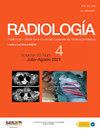弥散加权成像(DWI)定量分析提高了 o-rads rm 评分系统对不确定附件病变的诊断准确性。
IF 1.1
Q3 RADIOLOGY, NUCLEAR MEDICINE & MEDICAL IMAGING
引用次数: 0
摘要
尽管O-RADS MRI评分系统在诊断不确定的附件病变方面具有很高的准确性,但仍有不可忽略的百分比的附件病变仍然是不确定的。鉴于此,本研究的主要目的是根据国际卵巢肿瘤分析组织简单规则(IOTA-SR),评估在卵巢-附件报告和数据系统(O-RADS) MRI上增加定量弥散加权成像(DWI)的价值,以提高评分系统对不确定附件病变队列的诊断准确性。方法和材料79例经IOTA-SR诊断为不确定骨盆病变的女性,采用常规多参数方案进行3-Tesla MRI检查。定量分析DWI。病变手术切除或随访,根据当地协议。对常规多参数MRI和定量dwi衍生数据的敏感性、特异性、阳性和阴性预测值和准确性进行了测定。结果72例患者中有20个肿块为恶性,占27.8%。表观扩散系数(ADC)截止值为1.30 × 10-3 mm2/s,对恶性肿瘤的敏感性为89%,特异性为80%。总体而言,在O-RADS MRI上添加定量DWI可提高特异性(98.08%,P= 0.001)、阳性预测值(94.12%,P= 0.001)和准确性(93.06%,P= 0.05)。在特定的O-RADS MRI评分4亚组中,ADC截止值为1.22 × 10-3 mm2/s,用于区分良恶性病变的敏感性为86%,特异性为67%。结论在IOTA-SR不确定的附件病变中,定量DWI在所有O-RADS MRI评分组中均显著提高了常规多参数MRI的诊断效能。本文章由计算机程序翻译,如有差异,请以英文原文为准。
El análisis cuantitativo de las imágenes potenciadas en difusión (DWI) mejora la precisión diagnóstica del sistema de puntuación O-RADS RM en lesiones anexiales indeterminadas
Introduction
Despite the overall high accuracy of the O-RADS MRI scoring system for characterization of indeterminate adnexal lesions, a non-negligible percentage of adnexal lesions remains indeterminate. Given this, the main objective of this study was to evaluate the value of adding quantitative diffusion-weighted imaging (DWI) to Ovarian-Adnexal Reporting and Data System (O-RADS) MRI to improve the diagnostic accuracy of the scoring system in a cohort of indeterminate adnexal lesions according to International Ovarian Tumor Analysis Group Simple Rules (IOTA-SR).
Methods and material
Seventy-nine women with 81 pelvic lesions classified as indeterminate according to IOTA-SR underwent 3-Tesla MRI with a conventional multiparametric protocol. DWI was quantitatively analyzed. Lesions were surgically removed or followed-up, according to a local protocol. Sensitivity, specificity, positive and negative predictive values and accuracy were determined for conventional multiparametric MRI and quantitative DWI-derived data.
Results
Twenty masses in 72 patients (27.8%) were malignant. An apparent diffusion coefficient (ADC) cut-off value of 1.30 × 10-3 mm2/s had 89% sensitivity and 80% specificity for malignancy. Overall, adding quantitative DWI to O-RADS MRI increased the specificity (98.08%, P<.001), positive predictive value (94.12%, P<.001), and accuracy (93.06%, P=.05). In the specific O-RADS MRI score 4 subgroup, an ADC cut-off value of 1.22 × 10-3 mm2/s had 86% sensitivity and 67% specificity for distinguishing benign from malignant lesions.
Conclusion
In IOTA-SR indeterminate adnexal lesions, quantitative DWI significantly improves the diagnostic performance of conventional multiparametric MRI in all O-RADS MRI score groups.
求助全文
通过发布文献求助,成功后即可免费获取论文全文。
去求助
来源期刊

RADIOLOGIA
RADIOLOGY, NUCLEAR MEDICINE & MEDICAL IMAGING-
CiteScore
1.60
自引率
7.70%
发文量
105
审稿时长
52 days
期刊介绍:
La mejor revista para conocer de primera mano los originales más relevantes en la especialidad y las revisiones, casos y notas clínicas de mayor interés profesional. Además es la Publicación Oficial de la Sociedad Española de Radiología Médica.
 求助内容:
求助内容: 应助结果提醒方式:
应助结果提醒方式:


